GROWTH OF ROMAN EMPIRE
 Wenceslas_Hollar_-_.jpg)
By many reckonings the Roman Empire was formed in 27 B.C. by Augustus after the assassination of Julius Caesar in 44 B.C. Centered in Rome, it adopted many elements of ancient Greece culture but was based on military power and Roman law. Arguably in terms of technology and culture, Roman civilization was not surpassed in Europe until the Renaissance. By the death of Augustus (A.D. 14), the Empire included most of Asia Minor, Syria, Egypt, and the whole North African coast. [Source: World Encyclopedia]
The Roman empire was at its height in the second and third centuries A.D. At that time it included North Africa (by the conquest of Carthage in the three Punic Wars, 264-146 B.C.), the Holy Land, Egypt, Iberia (Spain), Gaul (France, conquered by Caesar in 56-49 B.C.), Britain (claimed in 43 A.D.), Asia Minor (Turkey), Macedonia (Greece) and Dacia (former Yugoslavia and Bulgaria, conquered in A.D. 117).
Websites on Ancient Rome: Internet Ancient History Sourcebook: Rome sourcebooks.fordham.edu ; Internet Ancient History Sourcebook: Late Antiquity sourcebooks.fordham.edu ; BBC Ancient Rome bbc.co.uk/history; Perseus Project - Tufts University; perseus.tufts.edu ; Lacus Curtius penelope.uchicago.edu; The Internet Classics Archive classics.mit.edu ; Bryn Mawr Classical Review bmcr.brynmawr.edu; Cambridge Classics External Gateway to Humanities Resources web.archive.org; Ancient Rome resources for students from the Courtenay Middle School Library web.archive.org ; History of ancient Rome OpenCourseWare from the University of Notre Dame web.archive.org ; United Nations of Roma Victrix (UNRV) History unrv.com
RECOMMENDED BOOKS:
“The Rise of the Roman Empire (Penguin Classics) by Polybius, translated by Ian Scott-Kilvert Amazon.com;
Pax Romana: War, Peace and Conquest in the Roman World
by Adrian Goldsworthy Amazon.com;
“Pax: War and Peace in Rome's Golden Age” by Tom Holland (2023) Amazon.com
“The Rise of Rome: The Making of the World's Greatest Empire” by Anthony Everitt (2013) Amazon.com;
“The Romans: From Village to Empire” by Mary T. Boatwright , Daniel J. Gargola, et al. | Feb 26, 2004 Amazon.com;
“Rome: An Empire's Story” by Greg Woolf (2012) Amazon.com
“The Grand Strategy of the Roman Empire from the First Century A.d. to the Third” by Edward N. Luttwak (1976) Amazon.com
“The History of the Decline and Fall of the Roman Empire” by Edward Gibbon (1776), six volumes Amazon.com
“Ancient Rome: The Rise and Fall of An Empire” by Simon Baker (2007) Amazon.com
“The Punic Wars” by Andrian Goldworthy (2001) Amazon.com;
“The Fall of Carthage: The Punic Wars 265-146BC” by Adrian Goldsworthy (2007) Amazon.com;
“Roman Conquests: Macedonia and Greece” by Philip Matyszak Amazon.com;
“The Roman Barbarian Wars I: The Era of Roman Conquest ” by Ludwig Heinrich Dyck (2020) Amazon.com;
“The Roman Barbarian Wars II: Tiberius to Trajan” by Ludwig Heinrich Dyck (2025) Amazon.com;
“SPQR: A History of Ancient Rome” by Mary Beard (2015) Amazon.com
“Atlas of the Roman World” by (1981) Amazon.com
“The Twelve Caesars” (Penguin Classics) by Suetonius (121 AD) Amazon.com
“Histories” by Tacitus (Penguin Classics) Amazon.com
“Enemies of the Roman Order: Treason, Unrest, and Alienation in the Empire” by Ramsay MacMullen Amazon.com
“Rome in the Late Republic” by Mary Beard and M Crawford (1999) Amazon.com;
“A Companion to the Roman Republic” by Nathan Rosenstein, Robert Morstein-Marx (Editor) Amazon.com;
Why the Romans Were Such Good Conquerors
"Wherever the Roman conquers, there he dwells," wrote the philosopher Seneca. Six hundred years of nearly continuous wars built an empire that stretched from Armenia to Britain The Roman's did not claim their territory with big decisive battles. The conquest of Gaul by Caesar was an exception. Rather the army campaigned every year and piece by piece they expanded their the empire outward.
Historian William Harris said few other cultures "displayed such an extreme ferocity in war while reaching a high level of political culture...almost every year the Romans went out and did massive violence to someone — and this regularity gives the phenomena a pathological character.” [Source: "History of Warfare" by John Keegan, Vintage Books]
What motivated the Romans to conquer. Most historians believe that it was not slaves or land. Many of the empire's slaves were prisoners of war, but scholars contend the slaves was not the purpose of the conquests. Much of the land taken by the Romans claimed wasn't worth much.
Cicero maintained that the Roman Empire was created accidently in the process of defending their territory against invaders. The Greek historian Polybius, who wrote 40 volumes about the history of Rome, concluded that Rome was "driven by a concept of manifest destiny, a compulsion to dominate."
According to Harris the Romans were motivated by the "expectation of successful war and conquest. Economic gain to the Romans was integral part of successful warfare and the expansion of power.” [Source: "History of Warfare" by John Keegan, Vintage Books]
Growth and Maintenance of the Roman Empire
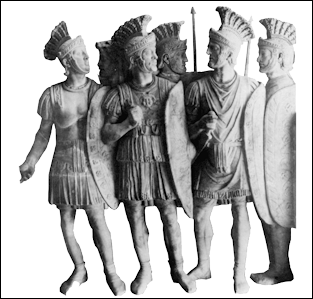
In the 1st and 2nd centuries, Britain was conquered; in the east. Roman rule extended to the Caspian Sea and the Persian Gulf, and further territory, including Dacia (Transylvania), was added in southeast Europe. The Empire was at its greatest extent at the death of Trajan ( A.D. 117), when it included all the lands around the Mediterranean and extended to north Britain, the Black Sea, and Mesopotamia. Hadrian (r.117–138) called a halt to further expansion.
J. A. S. Evans wrote in the New Catholic Encyclopedia: Trajan was the last great conqueror. He reduced Dacia to a province in two wars, ending in 106: an exploit that is commemorated by Trajan's column, which still stands in Rome. Dacia's importance was strategic: as a province it was not worth having, but it sustained Rome's control over the German and Sarmatian tribes across the Danube. Trajan's Parthian War ( A.D. 114–117) conquered Mesopotamia, but the province was in revolt at his death. Hadrian withdrew and consolidated. The empire switched to a new strategy of defending fixed frontiers. Hadrian's Wall in Britain, built 122/3–c. 133 between the estuary in the east and the Solway Firth in the west, is mute evidence of this strategy. It was built to control traffic over the northern frontier of Roman Britain, and Hadrian's successor, Antoninus Pius, considered it necessary to secure the frontier even more by building another wall further from the Firth of Forth to the Clyde. In Germany and Pannonia, the Rhine-Danube line was the frontier, but in the region between the two rivers, where the Neckar valley and the Black Forest offered an invasion route, Domitian had already a chain of small forts and watchtowers. Under the Antonines this system of fortification was completed with walls or palisades linking the forts, towers, and auxiliary bases. [Source: J. A. S. Evans, New Catholic Encyclopedia, Encyclopedia.com]
The army was stretched thin. Moreover, the civil war after Nero's death, which ended with Vespasian's accession (69 A.D.), had revealed the dark secret of the empire: the army could make or unmake an emperor, and troops fighting to install an emperor could not defend the frontiers at the same time. When Clodius Albinus took most of the Roman army from Britain for his ill-starred contest with Septimius Severus, the northern tribes invaded, breaking down Hadrian's Wall. Severus spent the last years of his life (208–211) campaigning there, and after he died at York, Caracalla conducted another successful campaign and then reestablished Hadrian's Wall as the frontier. Yet the army also played a role in the transformation of Roman society. Its corps of engineers provided a pool of expertise for building roads and bridges and even purely civilian projects like amphitheaters. Until Severus' principate, legionaries could not marry, but they did form alliances with women living near their camps, and they might wed them when they retired with their gratuities and savings and settle into civilian life with their families. Their sons not infrequently followed the example of their fathers and became soldiers. Auxiliary troops received citizenship when they retired. Thus the army was constantly feeding the citizenship roll.
Benefits for Conquered Territory
Although most Roman territories were annexed by force, they were governed with a fair degree of restraint, tolerance and judiciousness. Local leaders were often given positions in the Roman government and ordinary people and businesses benefitted from safe Roman roads, nourishing water systems, well-designed, beautiful buildings, and a reliable system of law, coinage and tax collection. Roman armies and navies protected the new provinces from invaders, pirates and bandits.
Within a fairly short time, the conquered people were made citizens of Rome and given all the rights and privileges that citizenship entailed. Any male regarded as worthy, regardless of ethnic background, could become a Roman citizen. “E Pluibus Unum” , the words featured on all American coins, meant that any position in the empire was open to suitable candidates regardless of ethnic group or background. Septimius Severus, a North African general became emperor of Rome and served for 18 years. Trajan, one of Rome's greatest emperors, was from Spain.
The third-century Roman emperor Diocletian proposed a single Europe currency but the idea didn’t catch on. Silver denarius” with the likeness of Roman emperors and other rulers was the single currency of the Roman Empire. It was accepted in such far flung places as Scotland, Egypt, Morocco and Romania.
Roman subjects were able to acquire riches and stability, unequaled in the ancient world, that they would have never been able to obtain on their own. The English historian Ronald Syme has argued that if George III had used Roman colonization as his model and shown more tolerance and incorporated the likes of George Washington, Patrick Henry and Thomas Jefferson into the local government then the American Revolution could have been avoided.
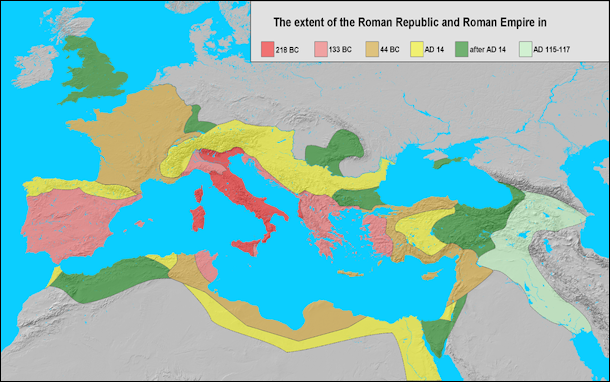
Extent of the Roman Republic and the Roman Empire between 218 BC and 117 AD
Everything wasn’t always peachy under the Romans. Under the command of Roman consul Lucius Mummius, when Corinth was captured, its men were slaughtered, women and children were sold into slavery, art was shipped back to Rome and Corinth was turned into a ghost town.
Early Rome Expands
Rome slowly expanded its territory in the centuries after the Republic was founded through skirmishes with rival states. The Etruscan states to the north were annexed in the fifth century B.C. and the Samnites and Greek colonies to the south were absorbed in the fourth and third century B.C.
Important conflicts laying the way for the creation of the Roman Empire included the annexation of Etruscan Veii, the first city state annexed by Rome, in 396 B.C.; the looting of Rome by the Gauls in 390 B.C.; and the defeat of the Samnite alliance in 295 B.C. Geese famously warmed the Romans of the Gallic invasion in 390 B.C.
Through military expansion, colonization, and the granting of citizenship to conquered tribesmen, Rome annexed all the territory south of the Po in present-day Italy during a hundred period before 268 B.C.. Latin and Italic tribes were absorbed first, followed by Etruscans and the Greek colonies in south.
One notable battle that the Romans lost took place in 280 B.C. in northwest Greece. King Pyrrhus of Epirus crossed the Adriatic with force of 20,000 men and some elephants and fought and defeated the Romans but took such heavy losses he exclaimed: “Another such victory and we are lost!” From then such as win became known as a “Pyrrhic victory.”
See Separate Article: ROMAN CONQUEST OF ITALY europe.factsanddetails.com
Early Stages of Creating the Roman Empire
In the fourth century B.C., Rome established itself as an important city state but it was still outclassed by larger, older and more formidable rivals such Alexandria, Athens, Syracuse, Corinth and Carthage.
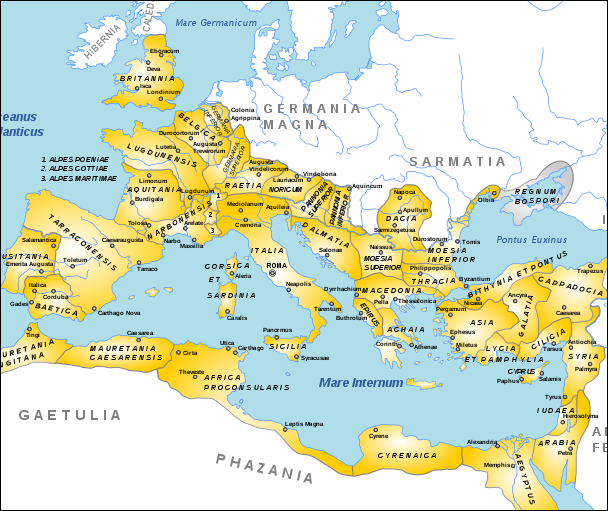
Roman Empire in AD 120
"If you were standing in the middle of the fourth century wondering who's going to conquer the world, you're definitely not going to bet on Rome" the British historian Wallace-Hadrill told National Geographic. The great city states of that time "had great navies, which Rome didn't have. But the Romans had their army, and they had this doggedness about them. They kept fighting these border wars, and they kept winning."
"Driven by political pressure and economic need — for grain, for slaves, for metals, for fabric, etc.”Roman expansion shifted into high gear after 260 B.C.," wrote journalist T.R. Reid in National Geographic. "One by one the great states of the Mediterranean fell before the onslaught of Roman legions."
The absorption of the various Italic groups seems to have followed the Faliscan model — where a compromise of some sort was reached with the Romans in which a degree of loyalty to Rome was rewarded with a degree of autonomy, rather than the Samnite model, conquest through a military victory. (See Samnites)
Niccola Terrenatio, a professor of classics and archaeology, told National Geographic: “We shouldn’t assume that the Roman conquest was such a traumatic event...it was more of a political reorganization to which everybody contributes. So your options, if you’re an Umbrian, say, are either starting your own conquest or joining with Rome. By 300 B.C. remaining a small-scale independent state is no longer an option...A lot of elites didn’t disappear with the Roman conquest. In a lot of cases they seemed to prosper from it. The Roman Senate fills with Faliscan, Etruscan families, people from all the supposed conquered lands. Economic power often stayed in the hands of those who had it before.”
Several Italic groups from the Italic League and fought with Rome in the Social Wars of 91 to 87 B.C. Rome prevailed and took control of the entire Italian peninsula but also gave Italic people citizenship in 90 B.C. After crushing Macedonian armies in the Balkans, exploiting land disputes in Greece and destroying Carthage in North Africa and Corinth in Greece in 146 B.C., Rome expanded its empire into Greece.
Punic Wars
The Punic Wars between Rome and Carthage were pivotal in making Rome a great empire. They began in 264 B.C., and lasted for 118 years with Rome ultimately prevailing. There were three Punic wars. They are regarded as the first world wars. The number of men employed, the strategies and the weapons employed were like nothing that ever been seen before. "Punic" come from the Roman word for "Phoenician," a reference to Carthage.
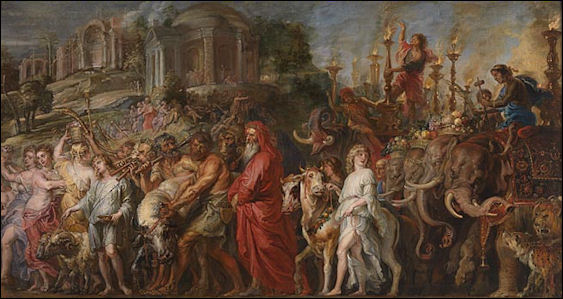
Roman triumph by Rubens
When the wars began Rome and Carthage were the two most powerful states in the Mediterranean. They both began as small cities and emerged as major powers around the 5th century B.C. They were briefly allied against the Greeks but later fought one another over lucrative trade routes.
Rome became the major power of the Mediterranean after it defeated Carthage, annexing territory in Sicily, North Africa and Spain. While fighting against Carthage the Romans also amassed large amounts of territory as spoils from wars against Macedonia, the home of Alexander the Great.
RELATED ARTICLES:
PUNIC WARS AND HANNIBAL africame.factsanddetails.com ;
FIRST PUNIC WAR (218-201 B.C.): ROME AND CARTHAGE BATTLE IN THE MEDITERRANEAN AND SICILY europe.factsanddetails.com ;
SECOND PUNIC WAR (218-201 B.C.): CARTHAGE SUCCESSES, ULTIMATE ROMAN VICTORY europe.factsanddetails.com ;
HANNIBAL: HIS LIFE, ACHIEVEMENTS AGAINST ROME, EXILE, DEATH europe.factsanddetails.com ;
HANNIBAL CROSSES THE ALPS: ELEPHANTS, POSSIBLE ROUTES AND HOW HE DID IT europe.factsanddetails.com ;
EARLY CARTHAGE VICTORIES IN THE SECOND PUNIC WAR (218-201 B.C.) europe.factsanddetails.com ;
THIRD PUNIC WAR: ROME DECISIVELY DEFEATS CARTHAGE europe.factsanddetails.com
Macedonian Wars
The Macedonian Wars (214–148 B.C.). The Macedonian Wars were a series of conflicts fought by the Roman Republic and its Greek allies in the eastern Mediterranean against several different major Greek kingdoms, with the main one being Macedonia. They resulted in Roman control or influence over the eastern Mediterranean basin, in addition to their hegemony in the western Mediterranean after the Punic Wars. [Source: Wikipedia +]
Traditionally, the "Macedonian Wars" include the four wars with Macedonia, in addition to one war with the Seleucid Empire, and a final minor war with the Achaean League (which is often considered to be the final stage of the final Macedonian war): 1) First Macedonian War (214 to 205 B.C.); 2) Second Macedonian war (200 to 196 B.C.); 3) Seleucid War (192 to 188 B.C.); 4) Third Macedonian War (172 to 168 B.C.); 5) Fourth Macedonian War (150 to 148 B.C.).
The most significant war was fought with the Seleucid Empire, while the war with Macedonia was the second, and both of these wars effectively marked the end of these empires as major world powers, even though neither of them led immediately to overt Roman domination. Four separate wars were fought against the weaker power, Macedonia, due to its geographic proximity to Rome, though the last two of these wars were against haphazard insurrections rather than powerful armies. [Source: Encyclopaedia Britannica]
See Separate Article: MACEDONIAN WARS: ROMANS DEFEAT THE GREEKS AND TAKE OVER THE EASTERN MEDITERRANEAN europe.factsanddetails.com
Creation of the Roman Empire Under Augustus
After Julius Caesar was assassinated in 44 B.C., a triumvirate made up of Mark Antony, Lepidus and Octavian took power. Octavian was the nephew of Caesar. The alliance didn’t last long. In 31 B.C., at the Battle of Actium, Octavian defeated Mark Antony and became the sole ruler of Rome. [Source: Hanna Seariac, Deseret News, April 22, 2023]
Octavian took the name of Augustus and became the official ruler of Rome in 27 B.C. During his life, he dramatically expanded the borders of Rome, established a road system and created public services for the city like a proto-police department and fire-fighting department and famously said “I found Rome a city of bricks and I left it a city of marble.” Some disputed Augustus’ reign, but at this point there wasn’t much internal fighting during his reign which would last until his death in A.D. 14.
After Augustus, the Roman Empire continued to expand both geographically and in terms of wealth. J. A. S. Evans wrote in the New Catholic Encyclopedia: Augustus and his successors built a system of imperial government to administer the empire’s vast territories and link them to the capital. This system, which allowed the provinces some measure of independence while being subject to Roman taxation and military control — functions crucial for the maintenance of the empire — proved quite efficient. Augustus settled former soldiers in the provinces, thus spreading Roman political and cultural influence and securing his power in distant lands. In addition, the Senate was opened up to provincial membership, so that by the second century AD, nearly half the senators were non-Roman. [Source: J. A. S. Evans, New Catholic Encyclopedia, Encyclopedia.com]
RELATED ARTICLES:
AUGUSTUS (RULED 27 B.C.-A.D. 14): HIS LIFE, FAMILY, SOURCES europe.factsanddetails.com ;
AUGUSTUS BECOMES EMPEROR OF THE ROMAN EMPIRE europe.factsanddetails.com ;
AUGUSTUS AS EMPEROR OF ROME: GOVERNING STYLE, WORSHIP, ADMINISTRATION europe.factsanddetails.com ;
AUGUSTUS'S POLICIES AND REFORMS europe.factsanddetails.com ;
AUGUSTUS'S ACCOMPLISHMENTS: BUILDING CAMPAIGN, PUBLIC WORKS, THE ARTS europe.factsanddetails.com
Colonization of Northern Africa

Road in Leptis Magna, Libya After destroying Carthage in the Punic Wars, Rome expanded its empire into North Africa. The north African territory it controlled became part of the Roman Empire. Julius Caesar had assured Rome’s dominion over North Africa in the battle at Thapsus of 46 B.C., where troops vanquished forces led by the father-in-law of his archrival Pompey. The client kingdom of Mauritania was annexed to the empire by Caligula in A.D. 40.
The colonies of North Africa were one of the most productive and easy to defend parts of the Roman Empire. Grain and olives grown along the southern Mediterranean and the Nile Valley fed much of the Roman Empire and deserts and mountains were so easy to defend that only one legion with 5,000 men was stationed in North Africa, compared to 13 along the Rhine and Danube in Europe.
Geraldine Fabrikant wrote in the New York Times, “By the second and third centuries, the North African region that is now Tunisia was one of the crown jewels of the Roman Empire. Rich in olives and grain, it had become a wealthy outpost of Rome, and Carthage, its sprawling port, was fast growing into a cultural and economic hub. Upwardly mobile citizens across Tunisia vied to imitate the Romans, their gods, their culture, their clothes and their lifestyles. And like conspicuous consumers everywhere, wealthy Tunisians wanted impressive homes: some of these villas were as large as 21,000 square feet.” Some of these house wonderful mosaics.
The North African provinces produced many distinguished Roman citizens. Juba II, the Berber scholar-king of Mauritania (ruled 25 B.C. to A.D. 23) was author of books on history, art and geography. He brought Greco-Roman culture to his capital of Caesarea and explored the Canary Islands. Juba arrived in Rome as a prisoner and became a classical scholar and favorite of emperor Augustus, who sent him to North Africa to marry the daughter of Cleopatra and Marc Anthony before he become king of North Africa. In A.D. 193, Rome had a North African Emperor, Septimius, who reportedly spoke with a Phoenician accent.
Septimius Severus (ruled A.D. 193-211), the founder of the Severan dynasty, was a senator from Libya who became Rome's first African emperor. With the rise of the African Severan dynasty, many of Rome’s senators were from Africa. Septimius Severus was succeeded by Geta (ruled A.D. 209-212, co-emperor with Septimus Severus and Caracallas 209-211, with Caracalla alone 211-212)
Mithridates

Mithridates VI Mithridates, the leader of the ancient Black Sea kingdom of Pontus (now northeast Turkey), did everything he could to overthrown the Roman Empire in the 1st century B.C. He lived from 120 to 63 B.C. and is source of the word “mithridate,” a confection believed to contain an antidote to every poison. He fought in several brutal wars in which he tried to free Pontus and surrounding lands, including Greece, from Roman rule. He came very close to succeeding, and if he had it might altered the history of the world with same impact as Hannibal winning the Punic wars.
The story goes that Mithridates became a boy king at an early age under his mother the regent, Queen Laodice. Fearing that she ultimately aimed to hold on to power by killing him, he fled Sinope, the capital city on the Black Sea, and headed into the mountains that tower above the Black Sea, where he won the loyalty of the tribes there, creating a political base that would later serve him well. When he was old enough to become king he rode into Sinope with his band of mountain warriors
His story is told in the book “Poison King” by Adrienne Mayor (Princeton University Press, 2009) and the historical novel “The Last King, Rome’s Greatest Enemy” by Michael Curtis Ford. He was a major character in Collen McCullough’s 1991 novel “The Grass Crown”, a fictionalized biography of the Roman dictator Sulla (138-78 B.C.)
Trajan’s Conquest of Eastern Europe and Mesopotamia
Trajan (A.D. 101-106) extended the Roman Empire to its furthest extent by conquering Dacia (Romania) and Mesopotamia. His armies extended the Roman Empire to the Persian Gulf by capturing Armenia in A.D. 114 and defeating several Middle eastern kingdoms, including the Parthians. Hadrian pulled back from the Euphrates and making peace with the Parthians. Marcus Aurelius and Marc Antony and Cleopatra also battled against the Parthians.
The Spaniard Trajan (A.D. 20-130) was the first Roman emperor to come from an outlying province. He extended the Roman Empire into present-day Romania, Hungary, and Bulgaria in A.D. 106 by defeated Germanic tribes in two Dacian wars (101-102 and 105-106). To achieve victory Trajan built a bridge across the Danube, a startling achievement for its times. The bridge and battles from the Dacian campaign are immortalized in 200 meters of scenes that spiral around the 100-foot-high Trajan column. The campaign ended when the Dacian king, Decebalus, was overthrown.
After the conquest of Dacia, the region north of the Danube became a Roman province. Rome shifted the majority of its defenses from the Rhine to the Danube, which became heavily fortified to protect Roman territory from hostile Gothic and Germanic tribes in the north.Trajan's bridge was torn down by Hadrian who felt that it might facilitate a Barbarian conquest of Rome. Roman monuments can be found all over Bulgaria and Romania. The Romanian language evolved from the Roman's Latin tongue.
The Roman city of Canustrum, which spread out over an area of four square miles and had a large legionary fort and an amphitheater that could accommodate 8,000 people, was built on the Danube about 25 miles from present-day Vienna. It was occupied from A.D. 14 to 433, when it was sacked by the Huns.
Trajan's armies extended the Roman Empire to the Persian Gulf by capturing Armenia in A.D. 114 and defeating several Middle eastern kingdoms, including the arch rivals of the Romans, the Parthians. Trajan died in 117 without yet receiving the news of these conquests. Qasr Bashir was a Roman fort on the eastern fringes of Roman Empire in present-day Jordan. Covering three quarters of an acre, it embraced stone walls and three-story-high towers and was situated on a low hill surrounded by rocks and sand.
See Separate Article: TRAJAN (RULED A.D. 98-117), HIS LETTERS AND TRAJAN'S COLUMN europe.factsanddetails.com

scene from Trajan's Column
Column of Trajan
Column of Trajan (at Fori Imperiali) is a 125-five-foot structure with a spiraling scene from Dacian Wars in the Balkans that if unwound would be 656 feet long. Built and inscribed between A.D. 106-113, the column was once topped by a statue of an Trajan, whose ashes and those of his wife are buried underneath its base. Originally it was supposed to be topped by an eagle. The statue of Trajan was destroyed in the Middle Ages.
To follow the narrative of the epic battle one has to walk around and around the column like a "circus horse" as one scholar put it. Even though the sculptures made at the top are bigger than those at the bottom, it is still hard to make them out. The figures were originally painted with bright colors and had metal weapons and the horse had metal harness.
There are a total of 150 separate scenes, the most interesting perhaps being the one that shows the Roman army crossing the Danube on a famous bridge. More attention is focused on the logistics of the battle than the actual fighting
The scenes show the interrogation of prisoners, the removal of booty, and finally the suicide of the Dacian chief while being pursued by the Roman cavalry. Dacian prisoners are treated decently after they have been captured, according to the images, while the Roman prisoners of war are tortured by Dacian women.
Roman Defeats
The Romans were not invincible. Describing a campaign in Belgium, Caesar wrote, "The soldiers were crowded too closely together to be able to fight easily...All the centurions of the first cohort were killed...and the chief centurion, Sexitius Baculus, a every brave man , was so exhausted by the wounds, arms and severe blows..he could hardly stand up." [Source: "History of Warfare" by John Keegan, Vintage Books]
The Parthian kingdom was Rome’s biggest rival in the East. They defeated the Roman army near the Euphrates and kept the Romans from advancing any further into Asia. The Parthians defeated the Romans in 53 B.C. at the Battle of Carrhae, one of the Roman Empire's worst defeats. The Romans were led by Crassus, the richest man in Rome. He purchased an army and was sent to Syria by Caesar. During the battle Crassus was captured by the Parthians, who according to legend, poured molten gold down his throat when they realized he was the richest man in Rome. The reasoning of the act was that his lifelong thirst for gold should quenched in death.
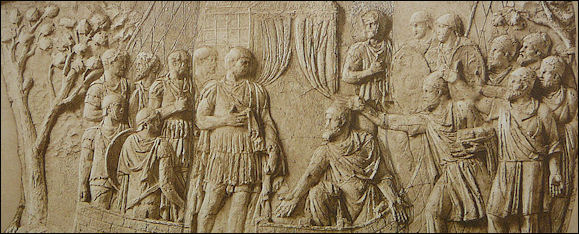
Trajan Column, Dacian chiefs
At the Battle of Cannae in the Punic Wars the Romans lost 50,000 out of 75,000 soldiers at the hands of Hannibal. The Romans were also badly defeated at the Teutenbourg Forest in Germany in A.D. 9. But all and all though the Romans suffered only a hand ful of defeats during their six- century-long period of domination. The Romans got their revenge against the Parthians under Caesar, who annihilated them in Zela in the Middle East in 47 B.C. After his victory he sent home the immortal message, "Veni, vidi, vici”" ("I came, I saw, I conquered").
Image Sources: Wikimedia Commons, The Louvre, The British Museum
Text Sources: Internet Ancient History Sourcebook: Rome sourcebooks.fordham.edu ; Internet Ancient History Sourcebook: Late Antiquity sourcebooks.fordham.edu ; “Outlines of Roman History” by William C. Morey, Ph.D., D.C.L. New York, American Book Company (1901) ; “The Private Life of the Romans” by Harold Whetstone Johnston, Revised by Mary Johnston, Scott, Foresman and Company (1903, 1932); BBC Ancient Rome bbc.co.uk/history/ ; Project Gutenberg gutenberg.org ; Metropolitan Museum of Art, National Geographic, Smithsonian magazine, New York Times, Washington Post, Los Angeles Times, Live Science, Discover magazine, Archaeology magazine, Reuters, Associated Press, The Guardian, AFP, The New Yorker, Wikipedia, Encyclopædia Britannica, Encyclopedia.com and various other books, websites and publications.
Last updated October 2024
